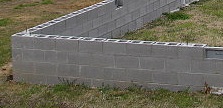Foundation Types for Your New Home: Pros vs. Cons
0 Comments | Posted by armchairbuilder in Build Your Own Home, Great Products
There are several major foundation types to choose from for your new home build. But how do you know which one will provide years of trouble free support for your new family home? To make matters worse, there are a bunch of people out there pushing one type or another because they have a vested interest in your choice. At Armchair Builder, we are here to give you an unbiased review so you can make the best selection for your particular situation. Let’s take a look at the main foundation types for a home with a basement and discuss the pros and cons of each.
Concrete Block
Back in the day, concrete block was the primary material for creating a foundation (after stone foundations anyway). Also called cinder blocks, these manufactured blocks are placed on a spread footing to support the weight of a home. Concrete block foundations are still used today…but have taken a back seat to poured concrete foundations over the last twenty years or so.
Pros: Low cost material; easy to find; relatively easy to install
Cons: Not as strong as alternatives…susceptible to lateral forces and buckling; Repairs can be costly because many times the foundation must be excavated from the exterior (think removal of landscaping, patios, decks…etc.); typically takes longer to install than other foundation types
Poured Concrete Foundation
These came on strong in the eighties and are still a big factor in new homes today. Forms are placed on top of spread footings, steel rebar is placed between the forms, and concrete is poured in. Forms sometimes come with different surface patterns, like brick, to provide a more finished appearance.
Pros: 8-10 inch thick, these foundations aren’t going anywhere…they are the strongest in compressive strength (crushing resistance); Easy to repair from the inside of a basement…a crack can typically be repaired within an hour or two without the need to excavate the outside of the wall; p0ured concrete foundation contractors are quite abundant and easy to find; two day construction for the average home…forms set on day one, poured on day two; relatively inexpensive
Cons: Need concrete plant nearby…this is not a problem for most parts of the U.S. but if you are building a cabin up in the mountains you may want to look at other foundation types
Prefabricated Foundation Walls
These are wall panels made in a factory and shipped out to your job site. They come in many different varieties, but one of the more popular uses wood stud wall construction as the structural component and then coats the exterior of the wall with a concrete layer to keep the moisture out.
Pros: Integrate insulation and waterproofing into the wall construction which reduces fingerpointing when a problem arises; absolutely level, plumb and square because the panels are made in a controlled environment; installs quickly once the panels have been made off site
Cons: Typically more expensive than other foundation methods…even when you add in the waterproofing and insulation (typically $3000 – $5000 more for the average home in the U.S.)
What Foundation Types do You Recommend
We frequently get this question having built a whole lot of homes. It’s a tough one to answer without seeing your bids for your particular project. You may have a prefabricated foundation wall panel plant near your project that lowers the cost to be in-line with the other options. However, we are strong proponents of poured foundation walls due to their strength and cost.
Whichever foundation you choose, be sure to put in the time to find a quality subcontractor with a strong reputation. Using our bid sheets and bidding system will allow you to locate the companies with the best pricing for a quality foundation. For more information about frost protection for your foundation, check out our article, Foundation Frost Protection. Before starting your new project, you may want to have a look at our article Preventing Home Foundation Problems.
Have you ever thought about building your own home? Be sure to stop by the Armchair Builder How to Build Your Own Home resource page.




